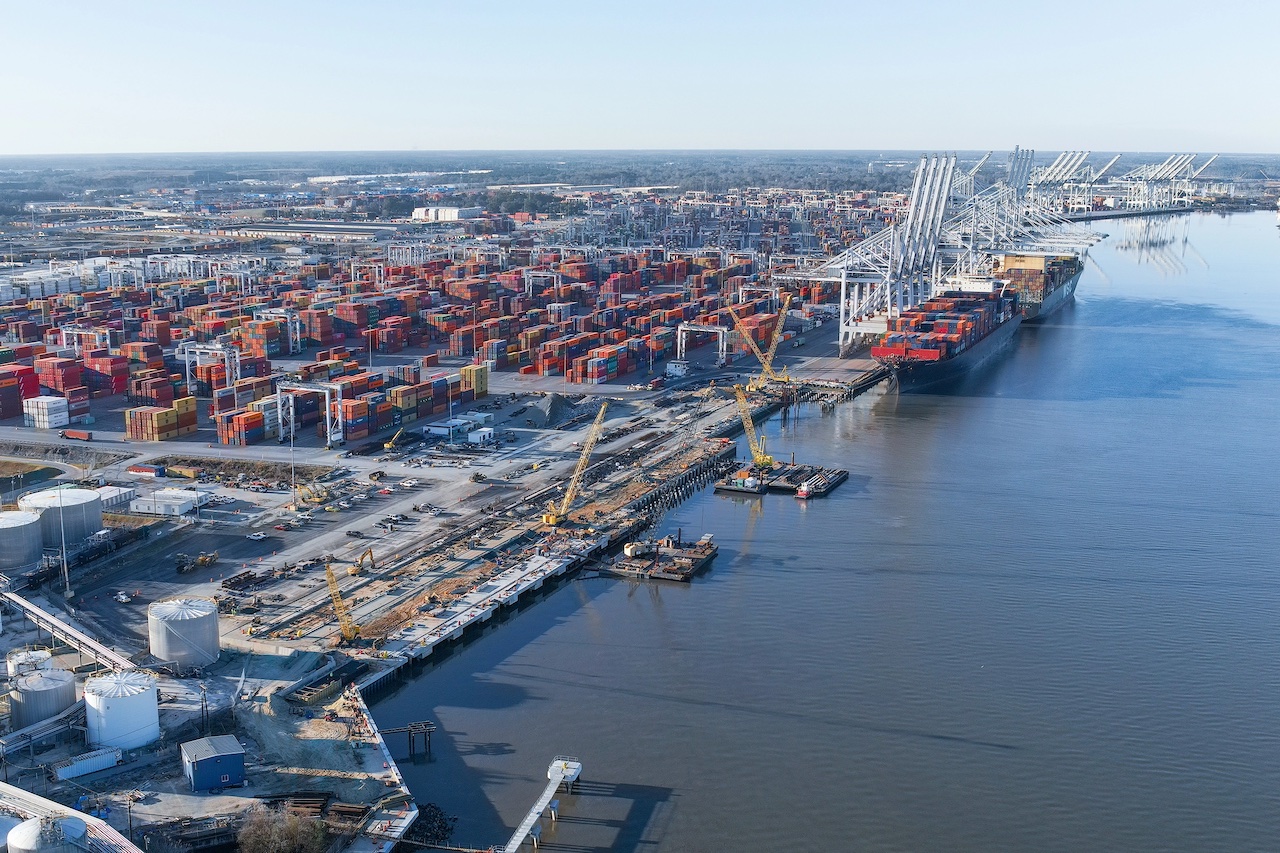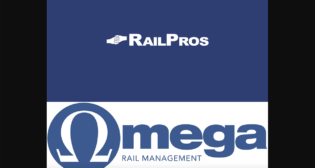
Intermodal Briefs: Georgia Ports Authority, Port of Virginia, CHS Inc./Cargill
Written by Carolina Worrell, Senior Editor
Big ship berth terminal in the works. (Photo Courtesy of the Georgia Ports Authority)
The Georgia Ports Authority (GPA) handles nearly six million TEUs (twenty-foot equivalent units) in 2022. Also, the Port of Virginia reports having processed more than 3.7 million TEUs in 2022; and CHS Inc. and Cargill will expand TEMCO LLC operations to include the Texas Gulf.
GPA
GPA announced Jan. 17 that it handled a record 5.9 million TEUs in Calendar Year (CY) 2022, an increase of 5% over 2021.
According to GPA, the Port of Savannah achieved four of its top five months for container volume in CY2022, with trade volumes peaking in August at an all-time high of 575,500 TEUs.
With the renovation of Berth 1 at Garden City Terminal to handle more than 16,000 TEU vessels, the 90-acre Garden City Terminal West expansion and the transition of Ocean Terminal to an all-container facility, the Port of Savannah is “set to increase annual capacity from six million to 7.5 million TEUs in 2023, and to nine million by 2025, GPA said. Learn more about GPA’s growth plans here.
In addition to record container cargo in 2022, GPA reported achieving a 16% increase in breakbulk tonnage to nearly 3.3 million tons last year, an improvement of 443,000 tons compared to 2021. In Roll-on/Roll-off cargo, Colonel’s Island Terminal in Brunswick handled 651,101 units of autos and heavy machinery. Ocean Terminal in Savannah moved another 19,630 Ro/Ro units, for a total of 670,731, an increase of 0.4%.
Total tonnage crossing all GPA docks reached 42.4 million tons last year, an increase of about 2% or nearly 760,000 tons.
“It was a challenging year, but collaborative effort across Georgia’s supply chain ensured cargo movement remained fluid,” said GPA Executive Director Griff Lynch. “I want to thank our Board for approving new infrastructure that allowed us to handle more cargo. Our gratitude also goes out to GPA employees and our partners at Gateway International, the International Longshoremen’s Association, trucking and rail. Their long hours and dedication were key to our success.”
“We’re excited about the possibilities ahead, with major infrastructure projects delivering greater capacity and efficiency for our customers,” added GPA Board Chairman Joel Wooten. “At Georgia Ports, we’re bringing to market faster vessel service, quicker turn times for trucks and more room to grow business.”
Port of Virginia
The Port of Virginia announced Jan. 18 that it has achieved its “most productive year on record” having processed more than 3.7 million TEUs in 2022, an increase of about 5.1%.
According to the Port of Virginia, the port achieved three of its top four months for container volume in 2022, with trade volumes peaking in May at an all-time high of 341,611 TEUs.
“We made real progress in 2022 and it was another very solid year for volumes,” said Stephen A. Edwards, CEO and Executive Director of the Virginia Port Authority. “Our service and performance levels continue to improve and each quarter our truck, chassis, rail and vessel performance metrics advanced. I want to thank all of our employees, the International Longshoremen’s Association and our supply chain partners for being significant contributors to our success.”
The port adds that its focus on its sustainability program and becoming a net-zero carbon emissions operation by 2040 also advanced. New capital projects using electric equipment coupled with power purchase agreements from exclusively clean energy production has the port on track–and in some areas ahead of schedule–to meet its 2040 goal.
“To ensure that we remain an economic engine, we are investing billions of dollars to create one of the fastest-growing and most technologically-advanced port complexes in the world,” Edwards said. “Now, we are coupling that investment with a twenty-first century approach to sustainability. The Port of Virginia is firmly committed to becoming a net-zero operation by 2040. Since announcing this commitment last year, we have a really good start and are making progress.”
Edwards attributes the successful year to multiple factors: an experienced operations team, constant preparation, efficiency, consistency and the Virginia Model.
“We own and operate the terminals and the Hampton Roads Chassis Pool and this allows for quick decision making that ensures we are doing the right thing for the customer within the capabilities of the operation,” Edwards said. “The users of The Port of Virginia have come to understand the Virginia Model, its benefits and the role it plays in our success cannot be overstated.”
The port says it is expanding its assets and building the benefits of the Virginia Model by investing in both long- and short-term projects aimed at “driving efficiency, capturing more cargo and preparing for the future.” Those projects include:
- NIT North: Renovate, expand and modernize the North Berth at Norfolk International Terminals (NIT) and create capacity for 1,400,000 TEU. This includes installation of new ship-to-shore cranes and a reconfigured container stack yard supported by remotely-operated, semi-automated, rail-mounted gantry cranes. This operation will mirror our operations at the South Berth of NIT and Virginia International Gateway. This project will be completed in two phases: phase I in 2025 and phase II in 2027.
- Dredging: Deepening (to at least 55 feet) and widening the Norfolk Harbor and commercial channels to safely accommodate fully-laden ULCVs (ultra-large container vessels) and ensure safe, two-way movement of these vessels. Scheduled for completion in 2025.
- NIT Central Rail Yard: Expanding the Central Rail Yard at Norfolk International Terminals (NIT) to accommodate 470,000 additional annual TEU. When complete, the terminal will be able to accommodate 1,100,000 annual rail TEU and the port will have annual rail TEU capacity of more than 1.8 million units. Scheduled for completion in 2024.
- Offshore Wind: The port is in the process of preparing Portsmouth Marine Terminal (PMT) to become the US East Coast’s logistics hub for the offshore-wind industry. The port has leased PMT to a pair of companies that will use the terminal as the staging and pre-assembly area for the components needed to develop a large-scale offshore wind farm off the coast of Virginia Beach. The terminal will be ready for occupancy in 2024.
“We are listening to our customers and cargo owners and are always looking for ways to improve how we process ships and move cargo,” Edwards said. “When we do this well, confidence in The Port of Virginia increases. The results are growing volumes and expanding businesses that help drive the state’s economy and job creation throughout Virginia.”
Cargo Snapshot CY2022 vs. CY2021
• Total TEUs – 3,703,230, up 5.1%
• Loaded Export TEUs – 1,076,146, up 2.5%
• Loaded Import TEUs – 1,728,911, up 2.9%
• Total Containers – 2,055,043, up 4.9%
• Total Breakbulk Tonnage – 157,385, up 6.6%
• Total Rail Containers – 679,838, up 5.8%
• Total Truck Containers – 1,283,515, up 3.6%
• Total Barge Containers – 91,690, up 18.1%
CHS Inc./Cargill
Agribusinesses CHS Inc. and Cargill announced Jan. 13 that they will be expanding the scope of their joint venture TEMCO LLC by adding the Cargill-owned export grain terminal in Houston, Texas.
The addition of the Houston terminal, which is located approximately 40 miles inland from the Gulf of Mexico via Galveston Bay, “will expand the TEMCO’s export capabilities, providing shipping access for grains, oilseeds and byproducts through the Port of Houston,” the companies stated in a release. With six million bushels of storage and capacity for 350 rail cars, the facility handles up to 250 million bushels annually. The terminal receives both trucks and railcars with a variety of commodities for global export.
“We’re pleased to continue to build upon our successful relationship with Cargill to expand the reach of TEMCO,” says CHS Executive Vice President of Agricultural Business John Griffith. “In keeping with our purpose of creating connections to empower agriculture, access to the Houston terminal provides additional options for area cooperatives and farmers to participate in the global marketplace, helping to advance CHS growth strategy for the region and open new opportunities for U.S. farmers.”
TEMCO currently operates three facilities in the Pacific Northwest: Portland, Ore.; Kalama, Wash.; and Tacoma, Wash. These three facilities distribute grain to global markets, primarily located in the Asia-Pacific region. Through TEMCO, both companies say they look forward to “building on 24 years of successful partnership to expand global grain market access for U.S. farmers to help meet the increasing global need for food.”
“We look forward to expanding our joint venture by integrating the Houston terminal and leveraging the successful operating model that’s in place today with TEMCO,” said Cargill President of North American Grain Sheryl Wallace. “We are excited to provide additional market access and opportunities for our farmer customers and to better serve our global demand customers.”
“The TEMCO team is excited to integrate the Houston terminal into our operations,” added TEMCO General Manager Brian Kubik. “This expansion will create efficiencies and opportunities for TEMCO and its employees.”



